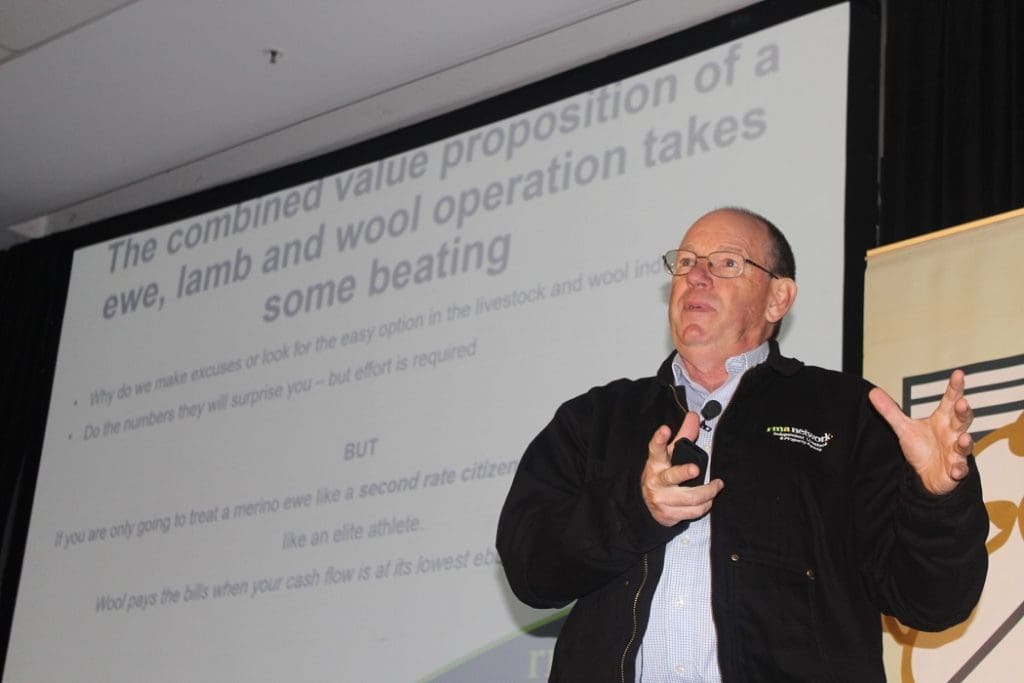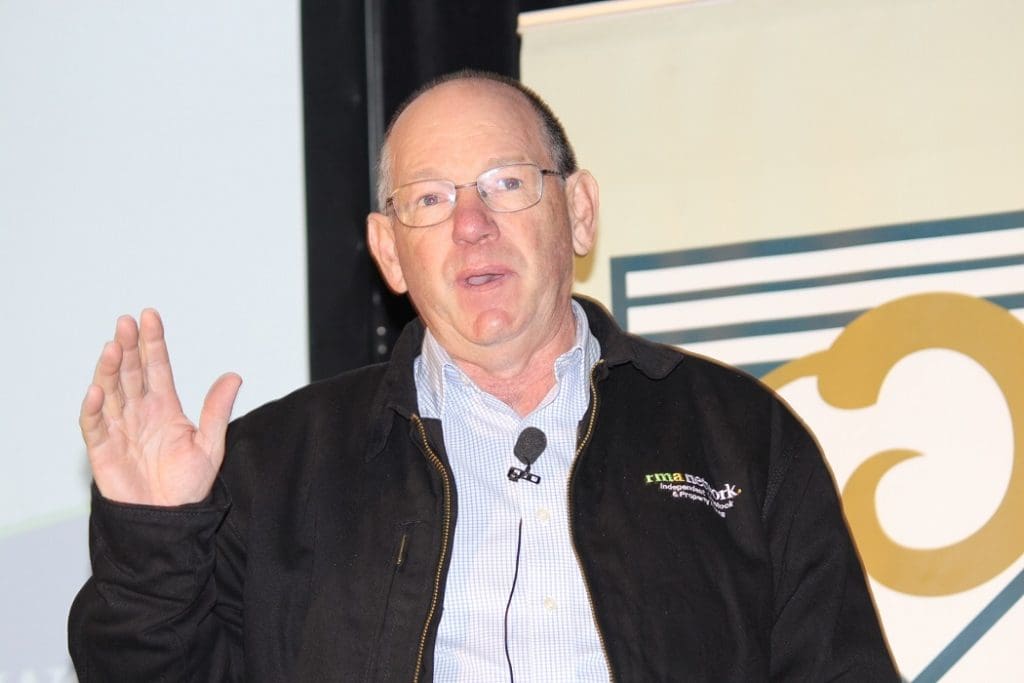
Chris Howie states the case for better treatment of the Merino ewe at the Bendigo conference.
LIVESTOCK producers must not sell their carbon credits, but appreciate their importance as a future market access tool, RMA Network Chris Howie told a packed 2023 BestWool BestLamb conference crowd in Bendigo this week.
“Do not sell your carbon credits, under any circumstances,” he said.
“At your own peril, carbon will become the new market access hurdle for us to get into the EU, into the UK, probably into America in time.
“And if you’ve sold them, when you go to a processor, because they are going to be looking at what your carbon footprint assessment is ….. hold onto them, because no-one understands what they are yet and once you’ve lost them, it is very hard to get them back.”
Mr Howie, formerly Elders national livestock manager and StockCo business development manager, took the opportunity to cover a wide range of topics outside the theme “Agents of the future – Relationships that create value.’
Cropping with sheep – know your target market
Mr Howie said cropping programs fit really ease into spreadsheets and banks love them.
But it was really hard to put a ewe/wool lamb operation, unless producers were experienced, knew where to get the right advice and knew their target market.
“You need to know where you’re going before you start.”
Mr Howie showed up a video of a commentator being surprised by a Spitfire taking off over his head, to make a point about “not knowing what was coming.”
“That’s exactly where we are and what we’ve looked at for the last six months.
“In November, as sure as God made little green apples the market was going to reset.
“We didn’t know it was going to reset by that much, but we knew it was going to reset.”
He said every time the cattle market reset it rained, stopping supply, and sheep producers couldn’t get weight gain into their lambs as they moved closer to cutting their permanent teeth and becoming hoggets. Producers who have unloaded underdone lambs into an over-supplied market, have done themselves a disservice by not realising their full market potential.
Mr Howie urged producers not to blame processors for the lower prices, but focus on having their lambs in the best condition they can, and think about strategic supplementary feeding “to stop that lamb being a slippery 2 score worth $100 to a hard 3 score worth $180.”
Know your kg/inputs to make improvements

Chris Howie urged sheep producers to know their cost of production.
After participating in the Global Food Sustainability Forum last year, Mr Howie related the examples of Singapore’ multi-storey barramundi farms and similar piggeries in China, made his point about the importance of thinking about kilograms of production/ha, rather than livestock turn-off, with an understanding of input costs and return on investment.
“I don’t want you to be thinking about how many lambs you put on the truck, how many bales you put on a truck, I want you to think about nothing but kilograms, because until you start thinking like that, no-one can help you improve your program.”
He said other industries – pork, dairy and chicken meat — knew what their inputs were and what came out, in kilograms.
“But we don’t do that – as producers and agents, we don’t do that.
“The second you get a baseline number, you’ve actually got the ability to improve, it’s like having a target, a career goal.”
Mr Howie said technology such electronic ear tags, autoweighing and drafting, real-time in-paddock weighing systems, and livestock watering sensors, gave producers the capacity to implement productivity management.
But he advised producers to map their carbon baseline first and add a remote water monitoring system afterwards “because it all adds into your carbon footprint.”
Are you your own agent and adviser?
He said if producers were not using agents or advisers, there must be someone in their business talking to the processors, wool buyer or feedlot “negotiating the deal.”
“The last time I looked that takes a fair bit of time.”
Mr Howie told producers that producing as many kilograms as can be produced in the shortest period of time – weight for age — would give the best return, unless a market pays for another trait such as intramuscular fat.
Making the point that production data is the new currency for livestock and wool, he said each operation needs to consider genetics, kill sheets and dressing percentages, curfew minimization to avoid faecal contamination, modifying shearing times to maximize yield and cut, marbling provenance and social license.
Send a message to Minister for Agriculture Murray Watt
“Everyone these days wants to know where something comes from,” Mr Howie said.
“That’s our social license … that’s the issue that we’ve got in Western Australia at present (live sheep export), so if you want to do one good thing for today, go out, send an email to Murray Watt, tell him to pull his head in.
“Because Western Australia needs live sheep exports and if anyone thinks stopping live exports in Western Australia is the end of it, it doesn’t stop,” he said.
“I’ve been involved in this for 15 years, it’s like a military campaign, they just come after you, they never stop.”
Merino wool and lamb combination is still the best
Mr Howie said the Merino wool and terminal lamb operation is still “by far hands up” the sheep producer’s best model, especially with development of better carcases within Merino bloodlines.
“The problem we’ve got with the Merino ewe is we do treat her like a second class citizen.
“You can’t expect her to perform like an athlete to get to 180 percent lambs if you’ve just got her out the back there (saying) ‘she’ll be right’ you know,” he said.
Is your agent transactional or a business partner?
Mr Howie said stock agency is one of the few jobs in the world that is underpaid for the work done until the stock are sold.
“If you are continually looking at how much commission you are paying you are treating your agent as a cost …. you and your agent need to have a chat or at worst you might need to change an agent.
“The good agent … we never had a conversation about the marketing fee because you were treated as an asset to the business, you were invested in the business,” he said.
“As a producer, you are in control of this.”
He said producers need to discuss with their agent the target market before the rams go out, determine the feed needed in a normal year, the property’s best livestock model, break-even return level, alternative production/marketing plans and who are the livestock buyers.
He advised producers to do a feed map on their farms – to know the weight gain potential of each paddock.
“And once you know that, you’ll never go back.”
He said he had seen lots of producers use their best feed to make their lightest lambs look like their heaviest, or spend 10 months to produce export lambs, when their operation was better suited for store lamb production.
He said producers could not put a forward contract in place unless they knew their break-even lamb price. While cotton growers who knew their cost/kg forward contract 18 months to two years ahead, while wool, “the most measured product in Australia forever and we still can’t get our heads around forward selling.”
“Take a little piece, take 20, 30, 40pc, the same with your lambs, because what that does is give you’re the core of your average.”
Mr Howie said producers can make their operations “really start to um” by having a plan B, C or D, finding out who bought their livestock and do they want them again “and can we put an arrangement in place.”
“If you are having the discussion about your sale program two weeks out, it’s too late.”
In his TAFE work, he teaches young agents to become business agents, not transactional agents, which many agencies were already doing.
He said ‘next generation’ agents invested in their client’s entire value proposition, target market and relationship and network opinions based on facts and market intelligence. It was also important to debrief with your agent after each sale or season, Mr Howie said, to improve the next result.
“The only reason I succeeded as an agent was because of my clients’ support and trust in my network.”
Markets are flooded, what should I do?
Mr Howie said currently the livestock supply chains were flooded and labour issues have constrained processors.
“It will shake itself out, there’s nothing surer …. but they are not going to crank up until the Spring.”
“You have to have a price discovery method and the price discovery method at present is the saleyards,” he said.
“But what’s happened is that supply has driven the price down, so the processors are holding more (kill) floor space open for the saleyard supply and so they don’t have to go with forward contracts,” he said.
Mr Howie said at this time of the year “as a rule” he would take the spot price on lambs.
“And then getting into August I would take a piece of end of August-September delivery as a forward — whether it is 30 percent of your supply, it might just be the heavies.”
“What that does is that you actually start sleeping at night,” he said.
“You’re really good at feeding lambs, at putting weight on them and you know what you’re going to get … and you move on, you’ve already started to think about the next crop; what can we do better?
“Instead of going to sell your lambs in the third week of September when we get a northerly change coming out through the Hay plains, a heap of feed comes on, a heap of lambs come into Wagga, a big heap of lambs come into Bendigo and the markets take a $15-$20 check,” he said.
“If you’ve already got two thirds of your supply locked away, you’re pretty comfortable.
“We’ve got to get away from the spot market,” Mr Howie said.
“You’ve got to know what your product is, you’ve got start looking further ahead and sometimes it’s hard, especially now, to cut a $7.50 deal for lamb at the current rate.
“The processors don’t want them all at the same time, and they definitely don’t want them at 1 or 2 score.”
Mr Howie believes the lamb market is a couple of weeks away from lifting, following by cattle in mid to late July.
He said producers willing to buy Merino wether lambs with 5cm wool at $70-$80 and run them through to $150 hoggets after shearing would “go alright.”
For their mental health, Mr Howie urged producers to move on from the shock, denial, anger and depression that might come from receiving negative feedback and take action.
“What do I need to do, who can help?”

HAVE YOUR SAY